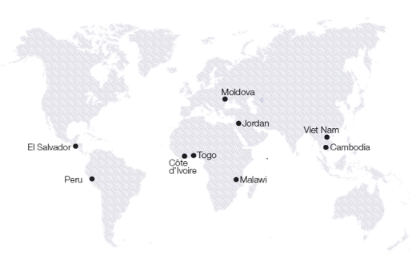Inclusive societies and development
Youth well-being policy review of Cambodia: A 60 seconds guide
 |
What is the Youth Well-being Policy Review of Cambodia?
|
The Youth Well-being Policy Review of Cambodia assesses the situation of youth in Cambodia using a multidimensional approach. For the first time, various dimensions of well-being are measured to capture the diverse facets of youth livelihood, including employment, education, health and civic participation. The review is based on the latest household-level data available. In the review, you will find:
The review is part of the Youth Inclusion project, co-funded by the European Union and implemented by the OECD Development Centre.
|
|
How's life for young Cambodians?
|
Despite Cambodia’s economic growth, young Cambodians face multiple challenges: according to the Youth Multi-dimensional Deprivation Indicator (Y-MDI) developed by the EU-OECD Youth Inclusion project, one young person in five is deprived in at least two well-being dimensions, including health, employment, education and civic participation, while 40% fare poorly in at least one dimension, mostly in education. Cambodia has made significant progress in achieving universal primary education. The enrolment rate in secondary school however, drops significantly, despite it being compulsory. Both access and quality of education are crucial issues and indicate a need for more relevant school curricula, better trained teachers and more resources for school improvements. Young people find it hard to integrate into the labour market due to limited education and training, poor access to job information and inadequate skills. Only 31% of youth have matching qualifications for their current occupations, while 23% are overeducated and 46% are undereducated. In addition, decent work is difficult to find for young people: almost three-fourth of employed youth are underemployed, with a higher proportion of poorly paid youth. About half of working youth in Cambodia are in the agriculture sector, but out of the 250 000 post-secondary graduates in 2014, only 3% are from technical and vocational fields like agriculture, science and engineering. For young people, agriculture equals hard labour and low income. Yet, the potential to develop profitable businesses along the agro-food value chain is real. Public investments are needed to improve rural infrastructure, and policies should support the training of farmers and rural youth in business development and marketing. Despite improvements in the health situation of youth, much remains to be done. The major challenges are sexual and reproductive health (SRH) issues, which affect mostly adolescent and young girls. Teenage (15-19) pregnancy affects 12% of girls. Early marriage and early pregnancy affect negatively education and employment outcomes for young women. In rural areas, they are three times more likely to become teenage mothers than their urban peers. Youth participation in politics has been limited. A majority of youth, especially those living in rural areas and migrant workers, are excluded from the initiatives of political parties and NGOs. The rapid spread of social media, however, is changing the situation: youth are increasingly informed and engaged in civic and political activities. However, the lack of trust in communities, political agendas and the justice system act as a barrier to participation. Furthermore, youth are cautious about participating in political activities due to the legacy of the war. |
|
Did you know...?
In 2016, the review estimates that 63% of children and youth aged 12-22 were already out of school. The reason for dropping out are complex and numerous, starting with the low value parents place on investing in education due to its poor quality. Young Cambodians themselves are pessimistic about the return on investment of education. In fact, in many occupations, primary and secondary school dropouts earn more than school graduates. It is only from higher education and vocational training that graduates earn more.
|
|
|
How to address those challenges?
|
In 2011, the Cambodian government developed the National Youth Development Policy (NYDP). The NYDP and its Action Plan (NYAP) reflect a new political engagement to involve youth and mainstream youth issues in various sectoral policies. As a way to operationalise the NYDP, the National Youth Development Council (NYDC) was established in 2013. This engagement needs to be supported by adequate funding and enhanced institutional capacity to implement the action plan. NYDP/NYAP need to be more systematically mainstreamed into the budgeting processes of various line ministries. Moreover, the NYDC should seek independent status to ensure an unbiased coordination role amongst stakeholders. Strengthening the capacity of NYDC’s General Secretariat would help it monitor and evaluate the implementation of the NYAP. Policies must take special consideration of the 80% of youth living in rural areas and make appropriate investments in the agriculture sector. Specific training policies should target women in order to help them improve their productivity, together with children’s day care and basic social protection to allow them to share their time between work and family. |
What can the government do?
|
Policy reforms need to take place on multiple fronts: Health
Employment
Education
Participation
|
Related Documents

